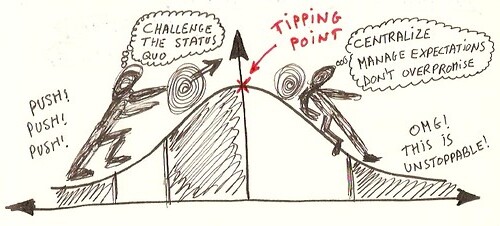This is just a reminder of two things we all know but fail to understand when it matters most: simplicity and synchronization.
In my opinion these are the factors that determine the speed of change and the moment when they matter most is the delivery phase of your project. In this article I would like to point out why.
Simplicity: Keeping it Simple
One of my favorite quotes in this regard is the one of Bill Jensen:
‘Change all you want, just know that execution happens at the speed of making sense’.
This means that people – and that includes you and me – will only do what they understand. At this point we are not even at the level of resistance – comprehension is the issue here!
However, there is a relationship: if you do a good job in sense-making you will be rewarded with less resistance. This implies that you not only tell people what they need to know to make the change happen, but you also listen, involve them and feed-back to them your understanding.
Synchronization: Staying on the Same Page
In the beginning of a project you may not be aware of the need for synchronization. Your project may still be building a prototype and you want to spread the word. In that phase any communication is good communication; whether it is structured or not, prepared or not, accurate or not – anything is better than radio silence (disclaimer: this is not an advice, it is an observed behavior).

But as you are approaching delivery and increasing the contact moments with your target audience people will urge you to get concrete, specific, accurate and fast. That is when your bunch of people (aka: the project team) needs to get disciplined about communication, testing and training (i.e.: the most important contact moments with the target audience).
As the drawing above illustrates, during the implementation phase more people become closely involved in the work of the program. You should be aware that this is also the first time that you meet pragmatists that hook into the details of the testing and conservatives who start to wonder what this is going to mean for them.
The Tipping Point
You will feel as if the big boulder of the project has reached a tipping point and is now rolling downhill. In other words: from now on you will have to pace the majority of pragmatists and conservatives who will be pushing you for concrete details. Therefore, during your communication it is important that you set the right expectations and that you do not over-promise with regards to delivering prototypes and demonstrating solutions. It is painful to be applauded for the demonstration of a certain solution only to find out that you overlooked some important elements because you did not consult the implementation team at large.
Your team is probably a big team by now and you must align solutions internally first before making promises to the organization. Minor and major incidents in this area will make you aware that you will need to centralize communication as you are approaching the delivery.
So if there is one sentence that you should keep telling yourself when your project is in the delivery mode it’s this one: ‘Let’s keep it simple and make sure we’re on the same page’.
Good luck!
______________________
In the illustration I make use of the following specific terms and representations:
1. The bell-shaped graph: Rogers, E.: Diffusion of Innovations, Free Press 1962
2. “The Chasm”: Moore, G.A.: Crossing the Chasm: Marketing and Selling High-Tech Products to Mainstream Customers, HarperBusiness 1999
3. “The Tipping Point”: Gladwell, M.: The Tipping Point. How Little Things Can Make a Big Difference,Little Brown 2000





